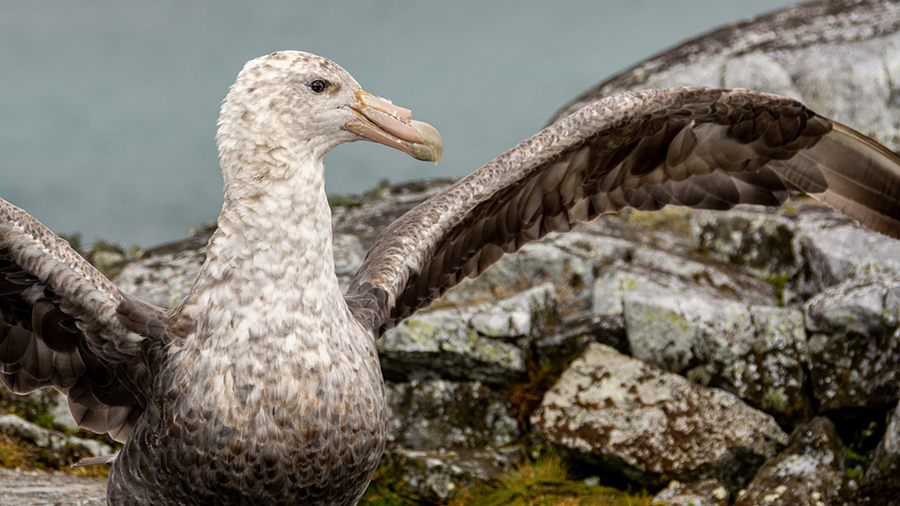On the Wings of PetrelsHow Giant Petrels Help Donna Fraser Get a Bird's Eye View Of an EcosystemPosted February 15, 2021
Ecologist Donna Fraser carefully makes her way across a low rocky ridge towards a mass of gray feathers with a beak. It's the baby chick of a southern giant petrel. 
Photo Credit: Mike Lucibella
Donna Fraser looks out over an island near Palmer Station home to numerous nesting giant southern petrels.
Gingerly, Fraser bends down next to it to take a few growth measurements. She checks the length of its beak, measures the size of its lower leg and weighs the creature. Throughout it all, the giant baby bird seems nonplussed. "It's working within their limits," Fraser said with an air of deep familiarity. "There's individual variability. There's grumpy ones and there's ones that don't care." Though she and her team study nearly all birds in the region, Donna Fraser's particular passion lies with the giant petrels that nest around the station. She is the field team lead of "The Birders" around Palmer Station. Headed by her husband, Bill Fraser, they study the many aspects of birds around the region, and not just the famous ones. "How many are there? Where are they eating? What are they eating? Where do they go and how are their chicks doing?" said Darren Roberts, a research technician at the Polar Oceans Research Group and another member of the birder team. "That's with a broad range of birds, not just with penguins. We do it with penguins, but also south polar skuas, brown skuas, cormorants, giant petrels and kelp gulls. If it has wings, for the most part." They're the bird-focused branch of the Long Term Ecological Research project that has been building a detailed picture of the region's ecology for decades. 
Photo Credit: Mike Lucibella
With a more than 6-foot wingspan, southern giant petrels can fly vast distances but only exert a small amount of energy.
"Our overall aim is looking at how healthy [the bird] populations are throughout the season, and that happens each season," said Megan Roberts, another research technician at the Polar Oceans Research Group and member of the team. They spend nearly five months each year tramping around the islands surrounding the station, monitoring which species are present, counting those that are, and taking their measurements to get an idea of their population's overall health. The data yields important insights into the health of the ecosystem as a whole. "We're using them as indicators of what's happening in the environment," Fraser said. "It's the long-term perspective of how all these things come together with the context of warming and human impact, it's what's happening." The research is supported by the National Science Foundation, which manages the U.S. Antarctic Program. Fraser and her team hold a permit issued under the Antarctic Conservation Act to handle the birds for research purposes. Birds Up CloseFraser knows the region well from her years working at Palmer Station. 
Photo Credit: Mike Lucibella
A giant southern petrel parent tends to its chick atop a ridge near Palmer Station. The petrels prefer to make their nests on top of peaks like this one.
"My first season at Palmer Station was 90/91," she said. At the time, she was working as an administrative assistant on the station, rather than part of a science team. But even then, she found ways to help further study the creatures living along the Antarctic Peninsula. "I volunteered and worked with some of the science groups," Fraser said. "I have a wildlife biology and zoology background so it wasn't a stretch to get out with other people." The following year she returned, this time as part of a team of physiologists doing Adélie penguin research on nearby Torgersen Island. At the same time, Bill Fraser was studying seabirds for the inaugural season of the Palmer Long-Term Ecological Research project. "He had a person who had to leave and go home mid-season, and my contract was about to end with the research group I was working with at the time, and it worked out quite well," Fraser said. "That was my first season with this birder group which was the first year of the LTER." The LTER is a research effort to closely study nearly every aspect of dozens of important ecological sites to fully understand how the ecosystems work and what affects them. Since 1980, the network has operated field sites across the United States. The 1991-1992 austral summer was the initial field season for the Palmer LTER, the first LTER site in Antarctica. The area covers the region adjacent to Palmer Station and a swath of sea off the Antarctic Peninsula the size of South Dakota. It brings together teams of researchers studying everything from tiny phytoplankton and crustaceans up to giant whales and seabirds. The goal is to take as comprehensive a look at the region as possible. 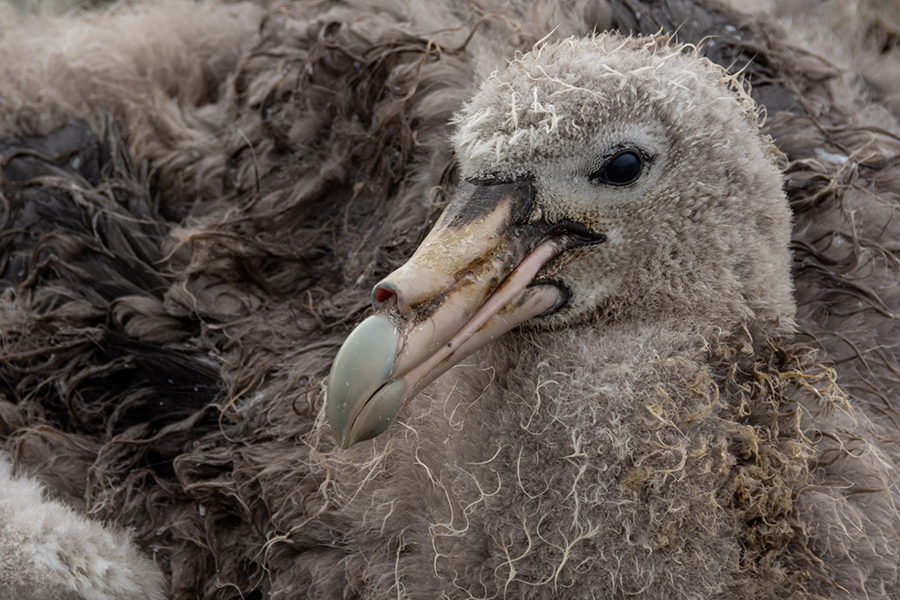
Photo Credit: Mike Lucibella
A giant southern petrel chick covered in down feathers nests in a rocky area near Palmer Station.
"With anything we do, one season is not going to tell you anything at all," Fraser said. She pointed to the late 1990s when the team first started attaching small GPS trackers onto several of the birds. At the time, scientists knew that petrels would sometimes fly hundreds of miles away from their nest in search of food, but they didn't know much about which ones did. "The first season I put [GPS] transmitters on giant petrels, it was absolutely split right down the gender line: males stayed within 75 miles of the station, females were doing those bomber trips," Fraser said. "The next season, it was like 'throw the cards in the air and see where they fall,' because it was completely different." Delicate ScienceLong before she could start attaching transmitters, Fraser needed to make sure that she was studying the petrels the right way. There was a great deal to learn about them. "Giant petrels were interesting because we did so little with them," Fraser said. "There were hardly any publications on them. Most of them are from the late '70s." Most of those were authored by Stephen Hunter, an ornithologist at the British Antarctic Survey who Fraser describes as her "giant petrel hero." He'd authored numerous studies of the birds, doing groundbreaking work on them. Even so, there was still much basic knowledge to be learned. 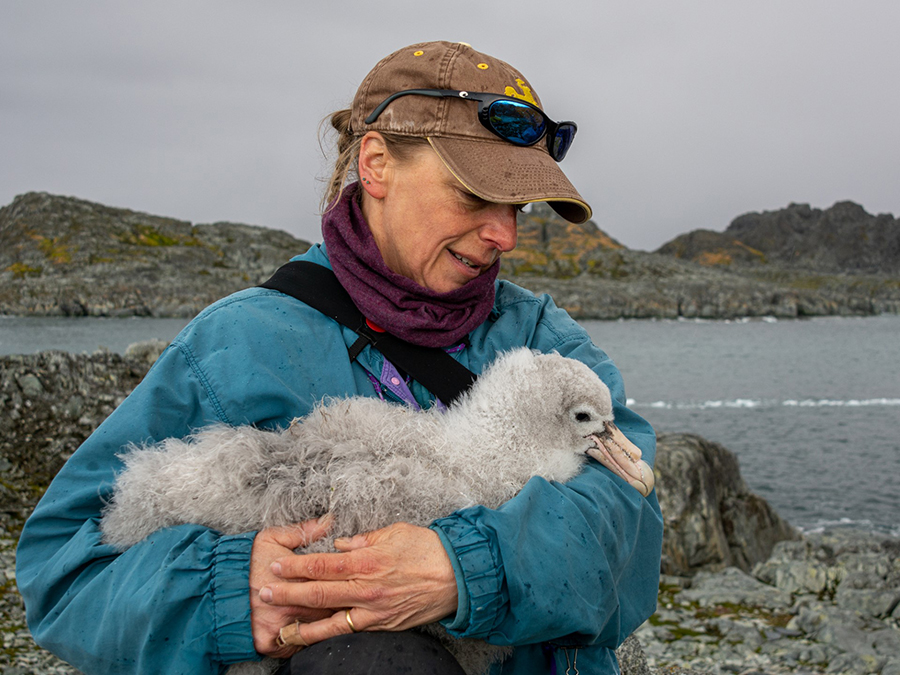
Photo Credit: Mike Lucibella
Donna Fraser gingerly picks up a giant southern petrel chick so as not to alarm it, a technique she's perfected over years of working with them.
"With giant petrels, there's two species, northern and southern, and maybe a sub-form around the Falklands," Fraser said. "But those weren't separated out until the mid-1960s. That's how new the knowledge and understanding is of the species; we're still trying to get our heads around them." Though eager to fill in the many gaps in knowledge about petrels, Fraser wanted to take her time, and make sure she was going about it compassionately and ethically from the start. "I don't want to be responsible for disturbance," Fraser said. "My own rule is as soon as I can tell that I'm causing disturbance, that's it, I pull the plug on myself." She spent her first season just walking through the petrel nesting colonies, recording what birds were around and observing their behavior. She paid particular attention to if they started to exhibit any discomfort at her presence. "It was a very gradual process of getting to the point where I felt confident in handling and approaching and that I was not causing long term disturbance," Fraser said. Over time, she's developed methods and techniques to work with the birds without disrupting them when it comes time to weigh their eggs and chicks. It's not only important to ensure accurate scientific data, but to ensure the wellbeing of the birds, particularly because of one of their more repugnant natural protective reactions. "Gaking is what we call their projectile vomit, and it's their defense mechanism," Fraser said. 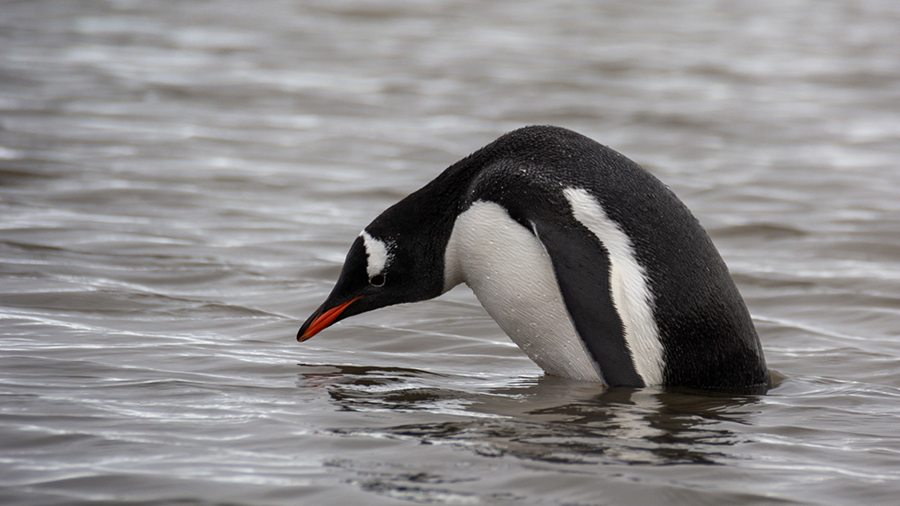
Photo Credit: Mike Lucibella
A Gentoo penguin hunts for fish. Over the last thirty years, Gentoo and chinstrap penguins, species acclimated to warmer climates, have moved into areas once occupied by Adélie penguins who are dependent on icy conditions.
When threatened, giant petrels will sometimes regurgitate over their attacker to ward them away from their nests. It can be an effective strategy for the petrels, but it comes at a cost. "Those chicks are losing meals," Fraser said. Fraser has always put the wellbeing of the birds over the scientific work she's in the midst of. Her standing policy for the team is no matter what, if the birds are uncomfortable or growing agitated, it's time to stop because that's what's best for the birds. "I am always ready to pull my own, 'No, I'm done because they're done with us,'" Fraser said. "Whatever it is that we're doing, if it's too much, that's it. There's no ego in being successful with them otherwise, you can just get into trouble." Changing LandscapeOver her thirty years working at Palmer Station, Fraser has seen dramatic shifts in the region from climate change. Penguin species that used to be endemic throughout the region are giving way to ones that thrive under warmer conditions. 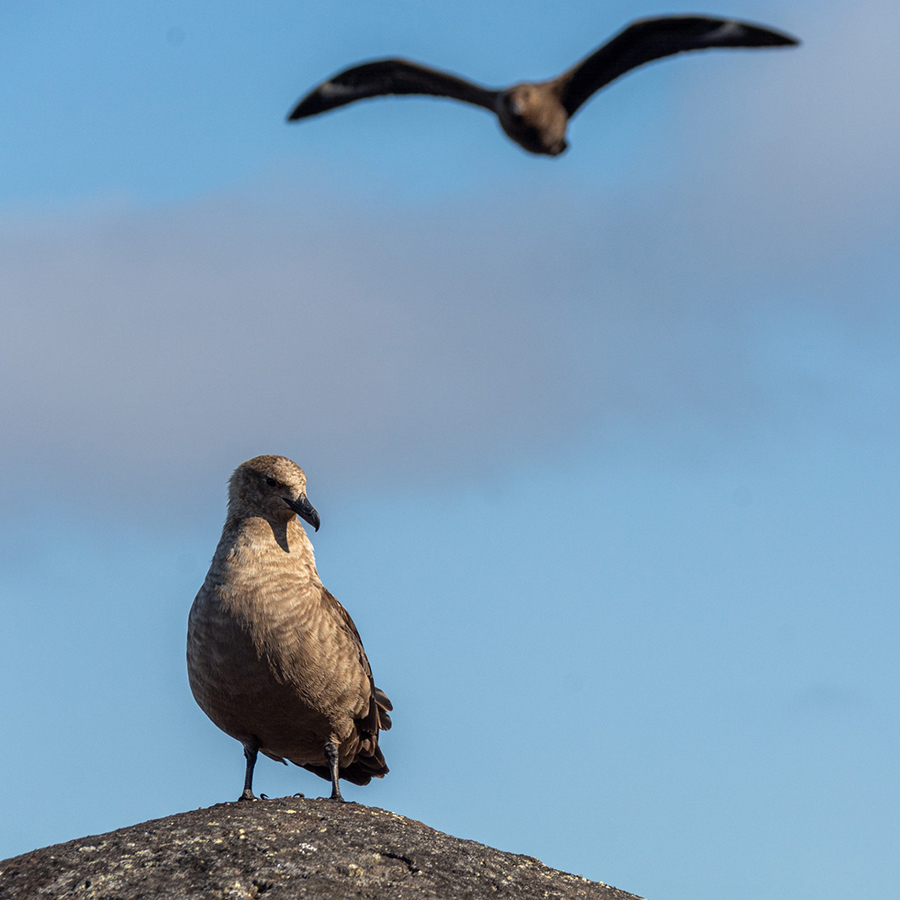
Photo Credit: Mike Lucibella
A south polar skua keeps watch as another flies by. Skuas are another species tracked by the birders.
"Adélie penguins have decreased by approximately 90 percent in this area," Fraser said. "[It's] the long term change from one dominant species to a different dominant species. From a species that needs sea ice fading out here to a species that doesn't need sea ice." In their place, Gentoo penguins have started moving in. "The first season we found gentoos was 93/94 and there were 14 pairs and we were like 'Woah, where did you guys come from?'" Fraser said. "Now they're everywhere… we have over 3,500 pairs." This change reflects a migration of the habitat optimum for the two species. Adélie penguins thrive in regions that are colder than what gentoos prefer. In particular, Adélies thrive in regions with frozen sea ice, while gentoos prefer ice-free regions. Climate change has warmed the region around Palmer station. "There's less sea ice now, and it's shifted the habitat optimum for Adélies farther south. "As we see gentoos increasing and Adélies decreasing it's an indication of that habitat optimum moving away for the Adélies and more into this area for gentoos." It's not just birds who are feeling the effects of a changing habitat. The team has also seen shifts in the seals that call the region home. "One of the things we're looking at with marine mammals, is how the ice-dependent species versus the ice intolerant species are changing," Fraser said. "When Bill [Fraser] started here [in 1974], I believe they saw six fur seals the entire year, and now you can't leave the 'house' without seeing them everywhere." 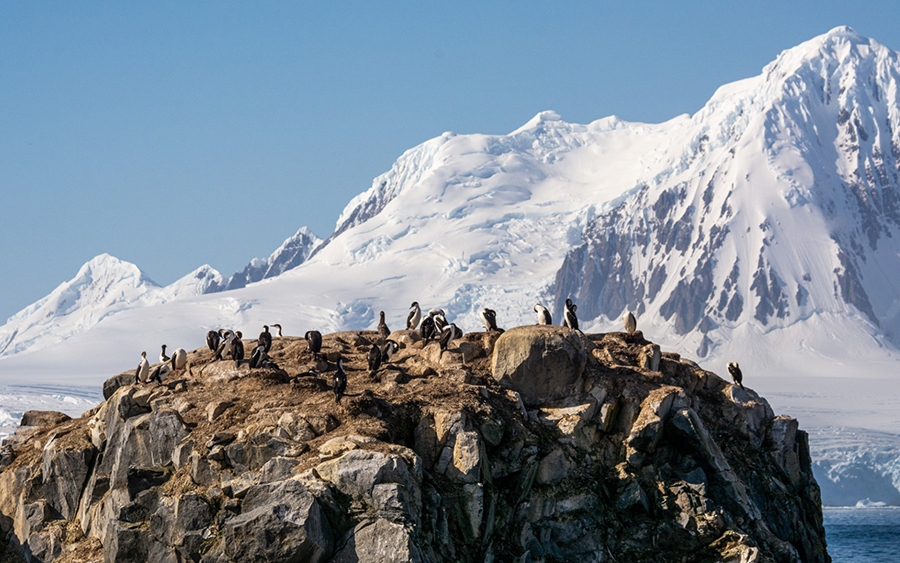
Photo Credit: Mike Lucibella
Blue-eyed cormorants, also known as Antarctic shags, nest on the aptly-named Cormorant Island, are another species tracked by the birders.
Though Fraser and her team study seabirds, they keep an eye out for researchers who aren't around to monitor some of the region's other animals. It's a collaborative effort, not only with other research teams in the Palmer LTER project, but anyone studying the region's wildlife. "We kind of go everywhere. It was really smart to say, 'We're here, just write down everything,'" Darren said. "It's ecology; we study the ecosystem. Sea birds are our main component, but we go places that nobody else goes." NSF-funded research in this story: William Fraser, Polar Oceans Research Group, Award No. 1745018. |



For USAP Participants |
For The Public |
For Researchers and EducatorsContact UsU.S. National Science FoundationOffice of Polar Programs Geosciences Directorate 2415 Eisenhower Avenue, Suite W7100 Alexandria, VA 22314 Sign up for the NSF Office of Polar Programs newsletter and events. Feedback Form |

